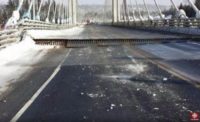

Authorities in the northeastern U.S. investigating flood-barrier technologies to block future flooding in subway tunnels have high hopes for one new device. A pressurized tunnel plug, tested this month, offers a lower price and quicker installation than competing, proven technologies.
"I called it a huge air bag at the beginning," says Ever Barbero, professor of mechanical and aerospace engineering at West Virginia University (WVU). Barbero calls his Dept. of Homeland Security (DHS) research contract "a high-risk, high-payoff proposal." During field tests, the risk was that the 32-ft-long "air bag" would fail; success would mean an added measure of nationwide security against extreme weather events or terrorist attacks.
"There are over 30 under-river tunnels nationwide," says John Fortune, project manager for DHS' Science and Technology Directorate. "We wanted a novel technology and new approach to solve this problem." The problem, as thousands of citizens and commuters around New York City found out, is tunnel flooding. With high payoffs in mind, Barbaro and WVU developed the 2,000-lb pressurized stopgap for tunnels.
"Existing floodgates have drawbacks like heavy costs and lengthy installations," says Fortune. Each existing tunnel flood barrier requires a singular design, he says. "We wanted a cheaper, more flexibly deployed strategy that would be customizable on a tunnel-by-tunnel basis," says Fortune. The price ceiling for a tunnel plug is $400,000, says Barbero. He thinks the unit cost will drop as the plug, manufactured by materials company ILC Dover, Frederica, Del., moves beyond the testing phase.
The plug, designed by DHS, ILC Dover, the Pacific Northwest National Lab and West Virginia University, is based on three critical criteria. The plug had to be strong enough to withstand a tunnel full of highly pressurized water. It had to be small enough to fit into a storage container whose size wouldn't disrupt daily tunnel traffic. Finally, the container and the plug itself had to be able to deploy reliably and remotely every time.
"The plug is made of three layers, two of which are Vectran, a [polymer synthetic] fabric similar to Kevlar, only more flexible and strong," says Barbero. The inner layer is a polyurethane-and-urethane bladder, built to contain air or water inside the plug itself. This layer sustains pressure inside the inflated bag to keep it in place via friction against the tunnel's interior. The second Vectran layer protects the bladder. The outer shell is a "basket weave" of Vectran webbing that provides strength and puncture resistance, says Barbero.
The redundancy of the woven fabric ensures that if a single point of the shell fails, the bladder will stay inflated, says Fortune. The container unit is also made of Vectran. It is repeatedly tested to ensure the plug will unfold properly when needed.
"The plug must be able to fill around contours of tracks, pipes and a third rail" without leaking more water than tunnel pumps can discharge, says Barbero.
The plug is competing against proven, flood-barrier defense systems. One system, tested by Rotterdam University and consulting engineer Arcadis, is Benelux Flood Defence Systems' self-closing flood barrier. It's a wall embedded in the ground that rises automatically—without electric power—as floodwaters fill the cavity below. The system currently protects the National Archives building in Washington, D.C., and other structures around the world. It is yet to be used to block tunnels but is currently being installed in 80 subway stations in the U.K.



Post a comment to this article
Report Abusive Comment